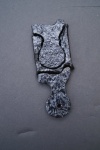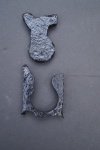
|
Confederate Griswold Revolver Factory Relics |
This is a good representative collection of Griswold Revolver components gathered from the ruins of the Confederate Revolver factory at Griswoldville, GA. The factory, owned by Samuel Griswold, was burned by Union cavalry on November 20, 1864. During the war, the factory produced over 3,600 revolvers for the Confederacy that were largely built by twenty slaves. We purchased these directly from a Macon, GA based relic hunter who dug these several decades ago around the factory site. Being an agrarian society, the South had very little in the way of manufacturing infrastructure when the war started. Griswold, who was originally from Connecticut, turned his small cotton gin factory into the largest pistol manufacturer in the South. While just old relics from the Civil War to some, these parts tell quite a story in how this little factory managed to turn raw pieces of iron into guns. Whenever we had the opportunity, we purchased duplicate components in various states of manufacture to give insight into how these components were manufactured 150 years ago. For example, we were able to acquire several cylinder arbor pins that go from raw iron bar stock that is notched for breaking into two pieces all the way to a round double threaded pin. There are hammers that range from raw stampings pressed and remainder of the heavy iron strip they were pressed out all the way to a fully filed and notched Griswold hammer. On the barrels, we were able to purchase the original 1" iron bar stock, the next stage of manufacture which is a piece of twist (this is where the bar stock was heated and twisted to diagonally re-distribute the grain structure, thus adding strength to the barrel) and two formed but not yet filed barrels. After the iron stock was twisted, it was wrapped over end to form a lug and forged into a barrel. You can still see the swirl of how the bar was wrapped over to form the lug as being in the ground for 100 years, Mother Nature rusted it in such a way that it exposed the grain structure. Another interesting insight is that both barrels never made it to full completion. It appears both were discarded due to crooked pilot holes in the initial boring. So there we see that not everything being made at the Griswold factory was making it through quality control. There are two loading levers, raw and mostly finished, plus a dud fulcrum. We were also able to acquire a rare casting of the iron frame that never went into full production due to warping problems in the casting process. As reported by relic hunters, there is very little in the way of brass to be found at the site. This is probably because Griswold was able to re-cast any defective parts. That said, we were able to acquire three cast pieces of brass used for forming the backstrap. We were also able to acquire a very good sub-grouping of small hard-to-find internal mechanical parts of these revolvers. Most of the smaller parts did not survive in the soil conditions to the extent of the larger components but we were able to get an original mainspring, trigger, hand/pawl for turning the cylinder, stop bolt, and even a barrel wedge. In addition, there are three cylinders and two loading lever rammers in two stages of manufacture. A few years after we acquired these, we were able to obtain another small grouping of Griswold relics that were from the actual factory itself. These consist of squared nails both large and small, chisels, and what looks like a fixture or jig for holding a revolver cylinder in place. There is also a fairly large chunk of slag...most likely skimmed from the main crucible used for casting brass. There is also a piece of what looks to be shrapnel from a cannonball. Over fifty pieces in all. This group can be arranged to show a nearly complete Griswold Revolver plus enough stages of duplicate components to lay out how certain individual components were manufactured. Done properly, this collection would make a very interesting display for a Civil War collection or museum. Item# 1913 $5,500 |
 |
 |
 |
 |
 |
 |
 |
 |
 |
 |
 |
 |
 |
 |
 |
 |
 |
 |
 |
 |
 |
 |
 |
 |
 |
 |
 |
 |
 |
 |
 |
 |
 |
 |
 |